Translate this page into:
Clinico-dermoscopic and pathological features of a rare presentation of erythema elevatum diutinum
Corresponding author: Dr. Biswanath Behera, Department of Dermatology and Venereology, All India Institute of Medical Sciences (AIIMS), Bhubaneswar, Odisha, India. biswanathbehera61@gmail.com.
-
Received: ,
Accepted: ,
How to cite this article: Kowe P, Behera B, Sethy M, Dash S, Sarkar N, Garg S. Clinicodermoscopic and pathological features of a rare presentation of erythema elevatum diutinum. Indian J Dermatol Venereol Leprol 2023;89:738-41
Dear Editor,
A 26-year-old man presented with a six-month history of three asymptomatic, persistent, slowly-enlarging red lesions on the dorsa of both the feet. He denied a personal or family history of leprosy. His medical history was unremarkable. Cutaneous examination revealed three well-to-ill-defined erythematous flat-topped nontender plaques of size 1.5 cm × 1.5 cm–5 cm × 4 cm on the dorsal feet. Areas of desquamation with fine white scales were also noticed [Figures 1a and 1b]. Dermoscopy (DermLite DL4, 10X) under polarised mode showed homogenous pink-white areas, diffuse dotted vessels and shiny white lines. The dotted vessels were prominent along the margins of the skin creases [Figure 2a and 2b]. The differential diagnoses included were borderline tuberculoid leprosy, patch-type granuloma annulare, psoriasis and pagetoid reticulosis. Histopathology revealed an acanthotic epidermis and a well-circumscribed nodular collection of inflammatory infiltrate in the lower dermis. The nodular collection showed neutrophilic leukocytoclastic vasculitis, including fibrin deposition, dermal oedema and a predominant lymphohistiocytic collection. In addition, many vessels showed features of vasculopathy with endothelial proliferation and luminal occlusion [Figure 3a–3d]. A diagnosis of erythema elevatum diutinum (EED) was made and the patient was treated with topical clobetasol 0.05% ointment.
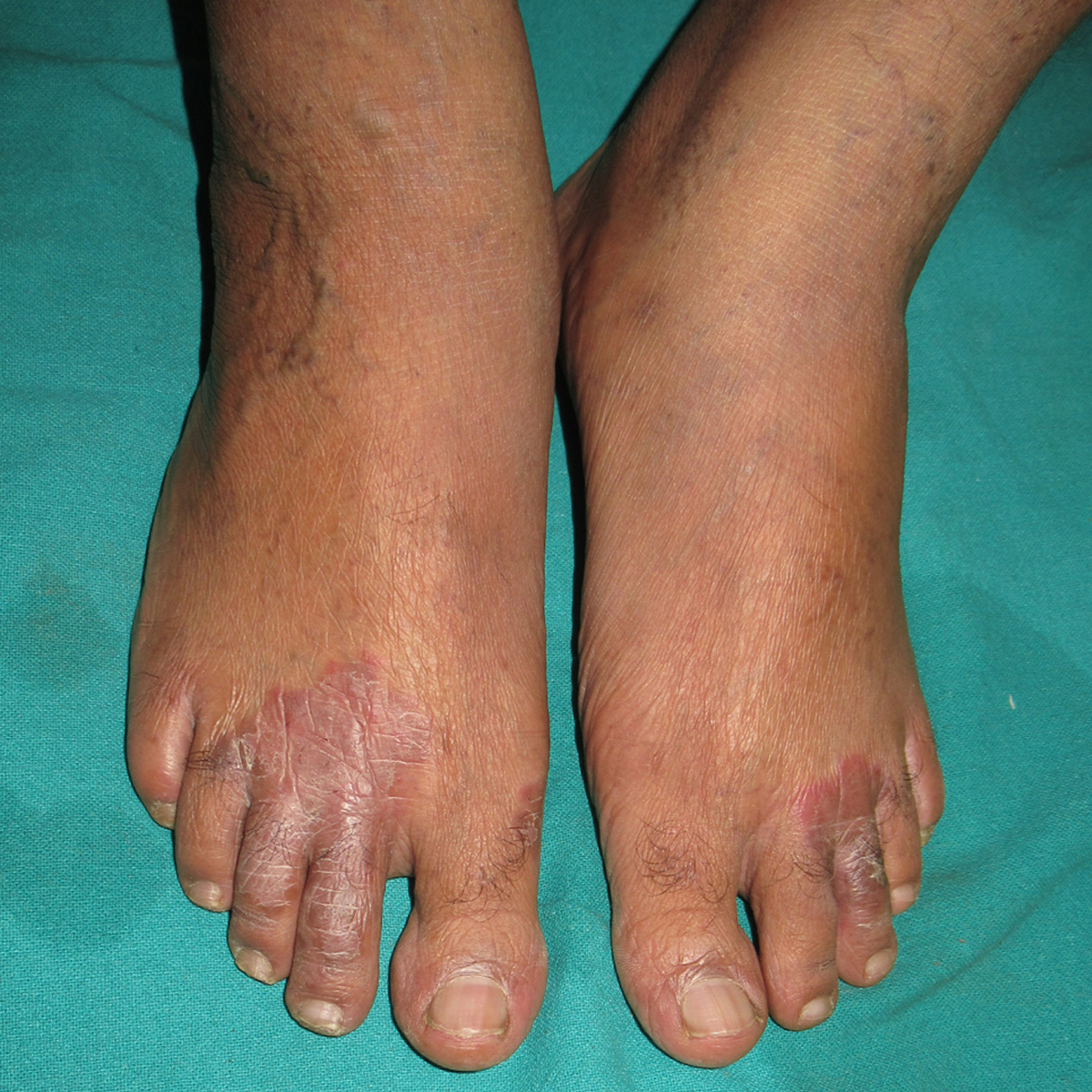
- Well-to-ill-defined erythematous plaques on the dorsae of distal feet

- Well to ill-defined erythematous plaque (arrow) on the medial aspect of the right foot

- Dermoscopy under polarised mode (Dermlite, DL4, ×10 magnification) shows homogenous pink-white areas, diffuse dotted vessels, and shiny white lines
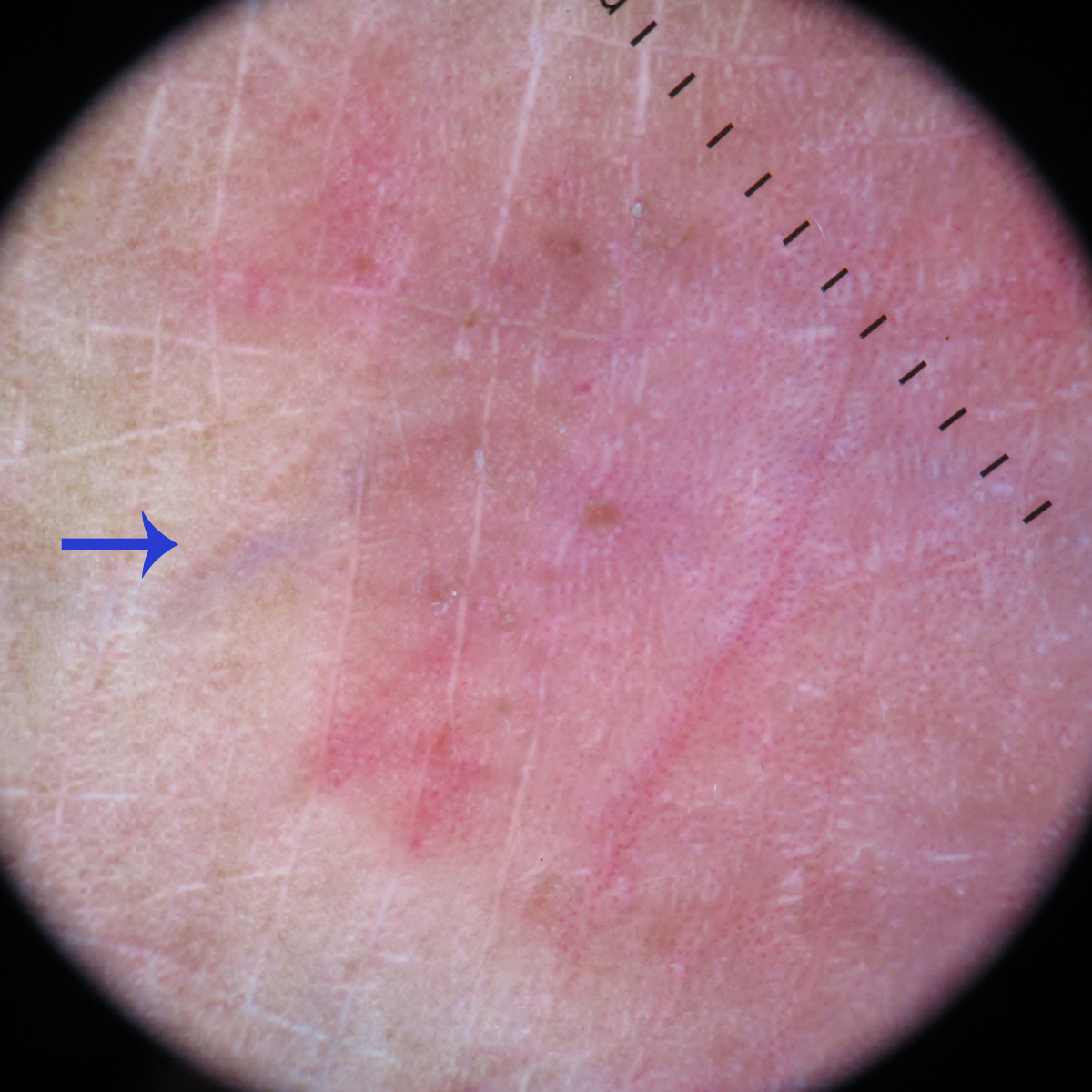
- Dermoscopy under polarised mode (Dermlite, DL4, ×10 magnification) shows homogenous pink-white areas, diffuse dotted vessels, and shiny white lines. Arrow points to the normal-looking surrounding skin
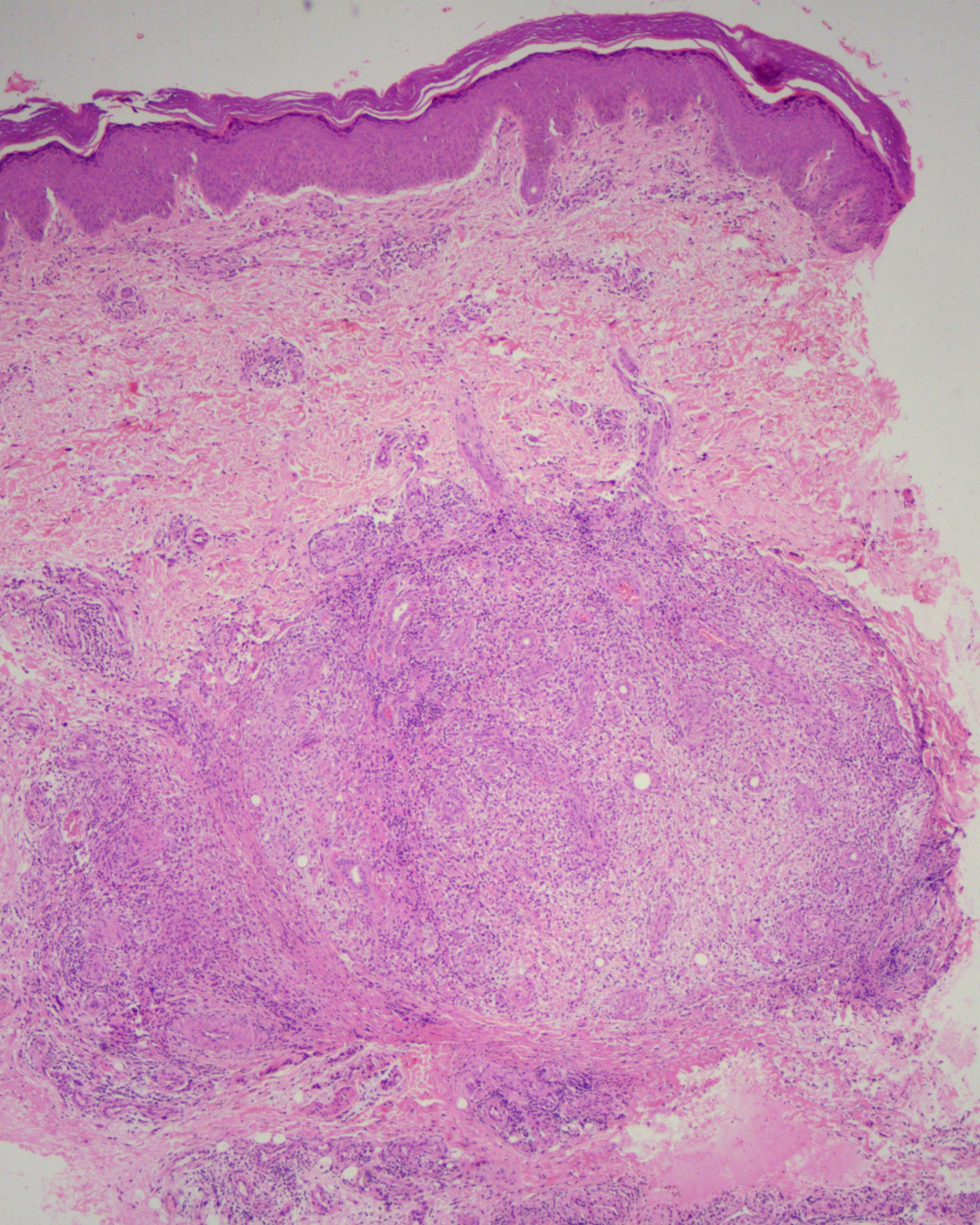
- Histopathology shows an acanthotic epidermis and a well-circumscribed nodular collection of inflammatory infiltrate in the lower dermis (H and E, ×50)
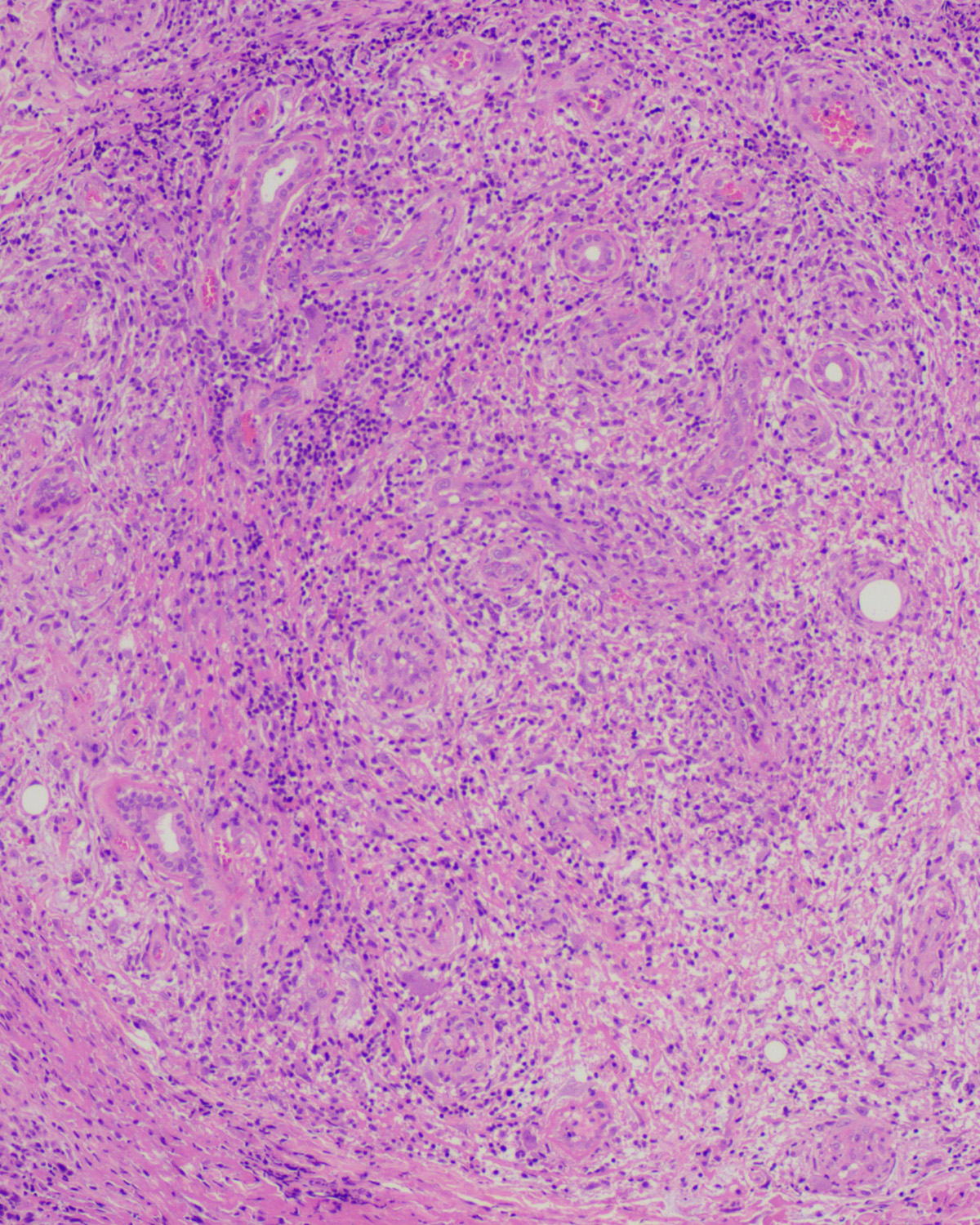
- The nodular collection shows neutrophilic leukocytoclastic vasculitis, fibrin deposition, dermal oedema, and a predominant lymphohistiocytic collection (H and E, ×100)

- Neutrophilic (arrow) leukocytoclastic vasculitis and leukocytoclasia (H and E, ×400)
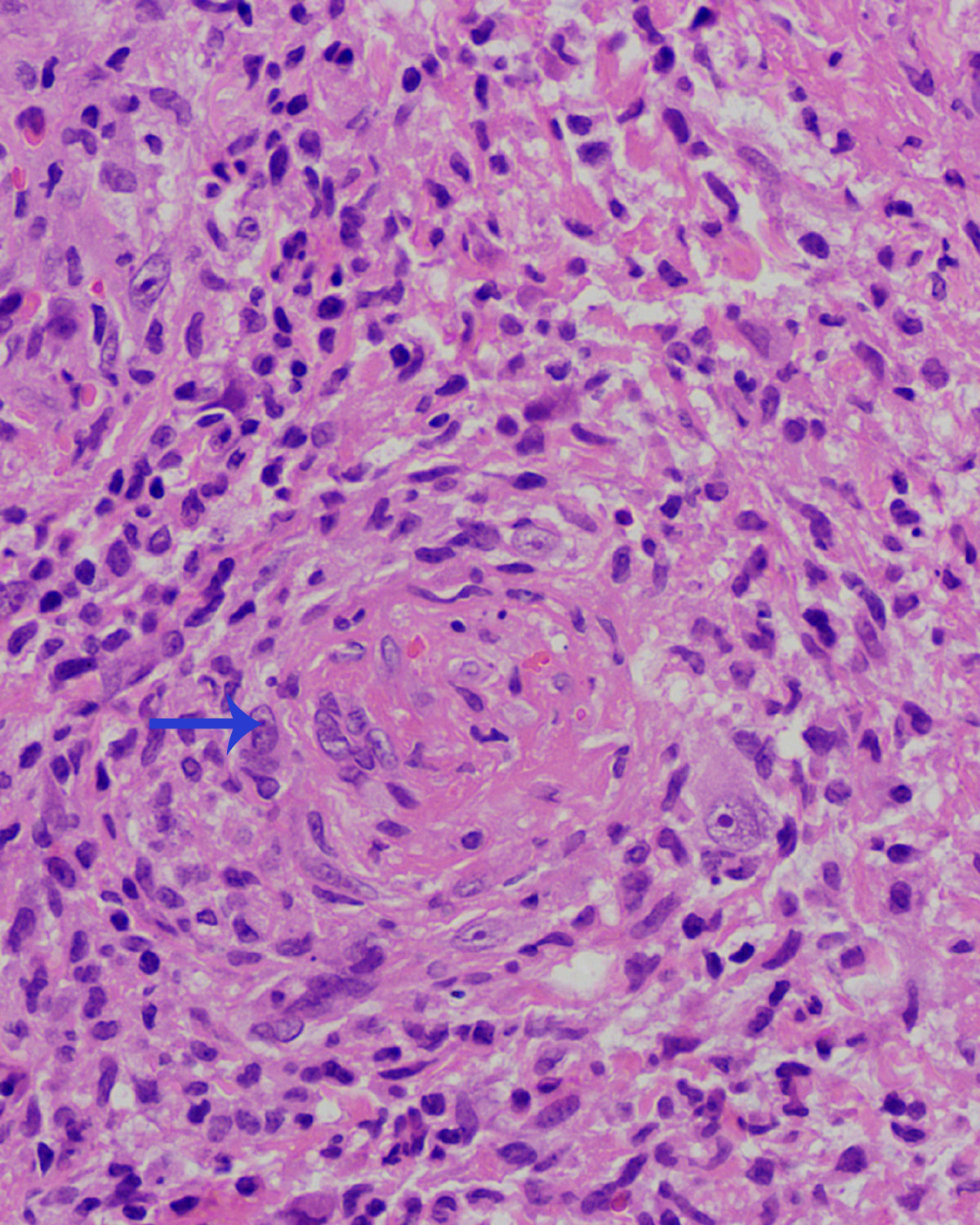
- Endothelial proliferation, fibrin deposition and occlusion of the vascular lumen (arrow) (H and E, ×400)
Erythema elevatum diutinum (EED) is a progressive and fibrosing form of immune complex-mediated localised vasculitis. 1 The clinical morphology varies from erythematous, violaceous to brownish papules and nodules in the early stages to yellowish-brown nodules in the advanced stages. Rarely, EED can be vesicular, bullous and ulcerative. 2 The most common sites are extensor aspects of extremities and include skin overlying the joints such as ankles, Achilles tendon, knees, elbow, hands and fingers. Uncommon sites are the retroauricular area, palms, soles, trunk and nipples. 3 The plaque morphology and location over the metatarsophalangeal joints, as in our case, have rarely been reported.
Dermoscopic description of EED is rarely mentioned in the literature. A solitary case of EED had a central white- to-orange area and purple spots on a reddish-purple background.
4 Another case from India showed yellow-red background, arborising telangiectasia and yellow-white streaks.
5 In the index case, the clinicodermoscopic features simulated psoriasis, borderline tuberculoid leprosy with or without reaction, patch-type granuloma annulare and pagetoid reticulosis [Table 1].6,7
Clinical diagnosis
Dermoscopic feature
Psoriasis vulgaris
Regularly distributed red dots or glomerular vessels on a reddish background and white scales
Borderline tuberculoid Hansen with or without type 1 reaction
5
Reddish backgroundWhite structureless areasYellow globulesFine short linear vessels or linear vessels with branching
Granuloma annulare(Patch-type)
A pinkish-red backgroundWhitish or yellowish-orange areasDotted, linear-irregular, and branching vesselsShiny white structures (rosettes, crystalline structures)White scales
Pagetoid reticulosis
6
Central homogenous pink areaA whitish network in the marginDotted or glomerular vessels
The diagnosis of EED is solely dependent upon clinicopathological correlation. The pathological features and its differential diagnoses may vary according to the stage of the disease. Neutrophilic infiltration and features of leukocytoclastic vasculitis characterise the early lesion. It can be associated with dermal oedema and may mimic Sweet syndrome. The established lesions show a mixed inflammatory infiltrate, granulation tissue and perivascular onion-skin fibrosis. The late or chronic stage is characterised by increased and thickened collagen bundles, sparse neutrophilic infiltration and variable xanthomatization. The angiocentric and storiform fibroplasia can be mistaken for dermatofibroma, sclerotic fibroma, sclerosing spindle cell perineurioma and sclerotic neurofibroma. 1 As per our search, only a single prior report had luminal occlusion by fibrin and inflammatory cells. 1 In our case, multiple vessels had luminal occlusion within the nodular infiltration.
In conclusion, we report a rare plaque-type of erythema elevatum diutinum in which the clinicodermoscopic features were misleading and the diagnosis was established by pathological examination. In addition, it had an unusual lower dermal nodular inflammatory infiltrate along with features of vasculopathy.
Declaration of patient consent
The authors certify that they have obtained all appropriate patient consent.
Financial support and sponsorship
Nil.
Conflict of interest
There are no conflicts of interest.
References
- Erythema elevatum diutinum: Clinical, histopathologic, and immunohistochemical characteristics of six patients. Am J Dermatopathol. 2005;27:397-400.
- [CrossRef] [PubMed] [Google Scholar]
- A rare case of erythema elevatum diutinum presenting as diffuse neuropathy. JAAD Case Rep. 2017;3:1-3.
- [CrossRef] [PubMed] [Google Scholar]
- Atypical presentation of erythema elevatum diutinum. Australas J Dermatol. 2005;46:44-6.
- [CrossRef] [PubMed] [Google Scholar]
- A clinico-dermatoscopic study of acral dermatosis. Int J Dermatol Venereology Leprosy Sci. 2020;3:35-41.
- [Google Scholar]
- Dermatoscopy of a case of erythema elevatum diutinum. J Eur Acad Dermatol Venereol. 2022;36:e316-7.
- [CrossRef] [PubMed] [Google Scholar]
- Dermoscopy of type 1 lepra reaction in skin of color. Dermatol Pract Concept. 2020;10:e2020083.
- [CrossRef] [PubMed] [Google Scholar]
- Dermoscopy of pagetoid reticulosis, with dermoscopic-pathologic correlation. Photodermatol Photoimmunol Photomed. 2019;35:372-74.
- [CrossRef] [PubMed] [Google Scholar]





